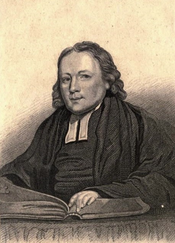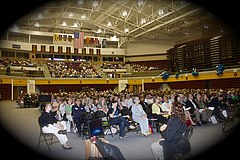History of Methodism in the United States
Christianity • Protestantism The history of Methodism in the United States dates back to the mid-18th century with the ministries of early Methodist preachers such as Laurence Coughlan and Robert Strawbridge.In 1735, the Wesley brothers, John and Charles, went to the Georgia Colony to minister to the colonialists and teach the Gospel to the Native American tribes.They were immediately preceded by the unauthorized Robert Williams who quietly set about supporting himself by publishing American editions of Wesley's hymnbooks without obtaining permission to do so.The first annual conference of the newly organized Methodist Episcopal Church was held at Green Hill House near Louisburg, Franklin County, North Carolina, April 19, 1785.Also, William Hammet (a missionary ordained by Wesley who traveled to America from Antigua with Bishop Coke), led a successful revolt against the MEC in 1791.The English Calvinist Methodist preacher George Whitefield played a major role, traveling up and down the colonies and preaching in a dramatic and emotional style, accepting everyone as his audience.People began to study the Bible at home, which effectively decentralized the means of informing the public on religious matters and was akin to the individualistic trends present in Europe during the Protestant Reformation.Circuit riders, many of whom were laymen, traveled by horseback to preach the gospel and establish churches until there was scarcely any crossroad community in America without a Methodist expression of Christianity.One of the most famous circuit riders was Robert Strawbridge who lived in the vicinity of Carroll County, Maryland soon after arriving in the Colonies around 1760.In New England, the renewed interest in religion inspired a wave of social activism among Yankees; Methodism grew rapidly and established several colleges, notably Boston University.[8] Methodism continued to expand into the Midwest - the Garrett–Evangelical Theological Seminary was founded in 1855 near Chicago by Eliza Clark Garrett in order to educate clergy for the region.Thus in 1936, Methodist Bishop James Baker, of the San Francisco Conference, released a poll of ministers showing 56% opposed warfare.[16] In Chicago, sixty-two local African Methodist Episcopal churches voted their support for the Roosevelt administration's policy, while opposing any plan to send American troops overseas to fight.While United Methodist Church in America membership has been declining, associated groups in developing countries are growing rapidly.Methodist denominations typically give lay members representation at regional and national meetings (conferences) at which the business of the church is conducted, making it different from most episcopal government (The Episcopal Church USA, however, has a representational polity giving lay members, priests, and bishops voting privileges).[21] The holiness revival was primarily among people of Methodist persuasion,[citation needed] who felt that the church had once again become apathetic, losing the Wesleyan zeal.Adding more complexity to the mix, there are United Methodist congregations who orient their worship to the "free" church tradition, so particular liturgies are not observed.Wesley's personal social philosophy was characterized by "an instructive reluctance to criticize existing institutions [which] was overborne by indignation at certain abuses which cried out for rectification.At the end of the 19th- and beginning of the 20th-centuries, the Methodist Church responded strongly to what it regarded as social ills (e.g., gambling, use of intoxicating beverages, etc.)After a comprehensive statement of the varied reasons slavery goes against "the laws of God, man, and nature", the Conference answered in the affirmative to the question, "do we pass our disapprobation on all our friends who keep slaves and advise their freedom?The apologia of the Southern churches was largely based in Old Testament scriptures, which often represent slavery as a part of the natural order of things."[25] The first two American bishops of the Methodist Church, Thomas Coke and Francis Asbury, opened a preparatory school in Abingdon, Maryland in 1787.In the 1870s, there was a broad movement toward incorporating Sunday schools into the doctrines of churches as a way to take ownership of the Christian education of children.Methodists invested heavily in the cause of Christian education because of their emphasis on the child's right to and ability to "respond to divine influences from the beginning.Methodism boasts the largest number of higher education ministries, including teaching positions, of any Protestant denomination in the world in close competition with the Southern Baptist Convention."[28] Because of this sense of duty toward the other members of the church, many Methodists were personally temperate out of a hope that their restraint would give strength to their brothers.Initially, the issue taken was limited to distilled liquors, but quickly evolved into teetotalism and Methodists were commonly known to abstain from all alcoholic beverages.To this day, the Women's Division of the General Board of Global Missions holds property on Capitol Hill in Washington, DC, which was built using funds provided by laypeople.The United Methodist Church delegates met in St. Louis on February 26, 2019, and voted 438 to 384 to maintain its policies defining marriage as a covenant between one man and one woman and barring "self-avowed practicing homosexuals" from serving as clergy.[35] Following the exodus of traditionalist United Methodist congregations from the denomination, in May 2024, the General Conference of The United Methodist Church convened in Charlotte, NC, and delegates voted to remove language defining homosexuality as sinful, along with restrictions on the ordination and marriage of LGBTQIA+ individuals from the Book of Discipline, the church's book of governance.







MethodismJohn WesleyAnglicanismArminianismFirst Great AwakeningMoravianismNonconformismPietismWesleyan theologyDoctrineOld TestamentNew TestamentCreedsNicene CreedApostles' CreedArticles of ReligionSermons on Several OccasionsExplanatory Notes Upon the New TestamentConditional preservationof the saintsPriesthood of all believersSainthoodFour sources of theological authorityCovenant theologySubstitutionary atonementImparted righteousnessNew birthOutward holinessPrevenient graceSunday SabbatarianismChristian perfectionSecond work of graceWorks of pietyWorks of mercyWorshipThe Sunday Service of the MethodistsCovenant Renewal ServiceRevival serviceAltar callMourner's benchCamp meetingTabernacleTent revivalBrush arbour revivalLovefeastWatchnight servicePeopleCharles WesleyRichard AllenFrancis AsburyThomas CokeJohn William FletcherOrange ScottWilliam Williams PantycelynBenjamin Titus RobertsWalter Ashbel SellewHowell HarrisAlbert OutlerJames VarickCountess of HuntingdonPhoebe PalmerGeorge WhitefieldTheologiansMethodist Church of Great BritainFree Methodist ChurchUnited Methodist ChurchWorld Methodist CouncilGlobal Methodist ChurchOther Methodist denominationsConnexionalismGeneral ConferenceMethodist CircuitPastoral chargeClass meetingPenitent bandHoliness movementConservative holiness movementHoliness PentecostalismEvangelicalismSaints in MethodismMethodist local preacherItinerant preacherCircuit riderStewardHomosexuality and MethodismOrdination of women in MethodismBishops in MethodismChristianityProtestantismBarratt's ChapelAsburyMethodistLaurence CoughlanRobert StrawbridgeAmerican RevolutionMethodist Episcopal ChurchSecond Great AwakeningsAfrican Methodist Episcopal ChurchMethodist Church (USA)Evangelical United BrethrenEvangelical Methodist ChurchCongregational Methodist ChurchAllegheny Wesleyan Methodist ConnectionBible Methodist Connection of ChurchesCharlesGeorgia ColonyNative AmericanMoravian ChurchConception BayPhilip EmburyBarbara HeckPhiladelphiaJohn Street Methodist ChurchDelawareMarylandbishopsRev. Dr. Thomas CokeGreen Hill HouseLouisburgFranklin County, North CarolinaRepublican MethodistsEdward EgglestonBishop Asbury CottageWest BromwichBaltimoreChristmas Conferencedeacon